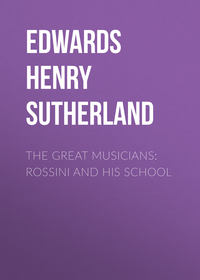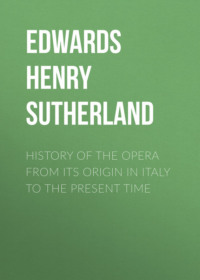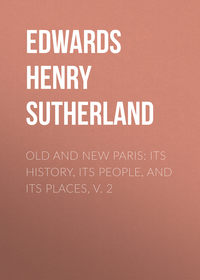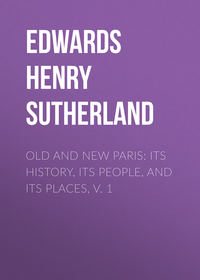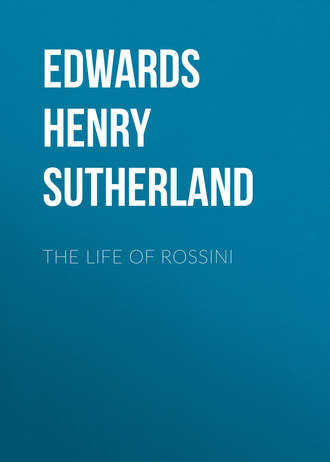 полная версия
полная версияПолная версия
The Life of Rossini
Everything that relates to Rossini’s earliest works is interesting; indeed at one time “L’Inganno Felice” was his very best opera – which it is evident that “Ricciardo e Zoraide,” the thirtieth on the list, never could have been. This last production, written in the year 1818 for the San Carlo, must have been admirably executed, the chief parts being entrusted to Mademoiselle Colbran, Benedetti the basso, and the two tenors, Nozzare and Davide; but it had the misfortune to be produced immediately after “Mosè,” and was crushed by the greater work.
Of “Ermione” little seems now to be known, except that the libretto was based on Racine’s “Andromaque,” that in addition to Mademoiselle Colbran and the two tenors, Davide and Nozzare, the celebrated contralto Pisarone (for whom Rossini, a few months afterwards, wrote the part of Malcolm Graeme) was included in the cast, and that the work, though presented on the stage with all possible advantages, made no lasting impression. It is not even certain that it made a very favourable impression in the first instance; and if “Ricciardo e Zoraide” lost by coming just after “Mosè,” “Ermione” can scarcely have gained by coming just before “La Donna del Lago.”
Stendhal – an untrustworthy guide, the more so as he makes no distinction between his own personal opinions and those of Carpani, from whom he so constantly borrows – informs us that the music of “Ermione” is composed in the declamatory style of Gluck. M. Azevedo says that it is written in the simple, vigorous style adopted by Rossini for treating the subject of “Guillaume Tell.” The two statements may be reconciled, if indeed (which is quite probable) one has not been suggested by the other. It may be said generally, that in “Ermione” the composer studied the dramatic requirements of his subject more than the vocal capabilities of his singers. The experiment does not seem to have been successful as far as the public taste was concerned.
But between “Ermione” and “La Donna del Lago,” both produced at the San Carlo at Naples, Rossini brought out “Eduardo e Cristina” at Venice.
According to the author of Le Rossiniane, “Eduardo e Cristina” was little more than Rossini’s two previous operas, “Ricciardo e Zoraide” and “Ermione,” in another shape. The manager of the San Benedetto Theatre at Venice had engaged Rossini to furnish him with a work for the Spring season. But urgent private affairs detained the composer at Naples, which he could not prevail upon himself to quit until about ten days before the day fixed for the production of his new and original work.
It is true that Rossini had in the meanwhile forwarded a good many pieces of music to the expectant manager. The words were not always the same as those which the manager had forwarded to him, but no one, not even the manager, pays much attention to the words of an opera, and the Venetian impresario was only too glad to get the music.
Nine days before the day of performance Rossini arrived in Venice to give the finishing touches to his work, see it through the rehearsals, and direct the first representation.
The opera was immensely applauded; but after the first two or three pieces the audience all remarked a Neapolitan merchant in the pit who seemed to know the work by heart, and anticipated the vocalists in singing the principal melodies.
His neighbours asked him how he came to have heard the new music.
“New music?” replied the merchant; “it is a mixture of ‘Ricciardo e Zoraide’ and ‘Ermione,’ produced at Naples six months ago. The only thing new is the title. Rossini has taken the most beautiful phrase from the duet in ‘Ricciardo,’ and turned it into a cavatina for your new opera. Even the words are the same. ‘Ah nati in ver noi siamo.’”
During the entre-acte, and while the ballet was going on, the story of the Neapolitan merchant, after being told in the theatrical café, soon spread in the theatre itself. The local dilettanti, who had been vying with one another in sounding the praises of the work, were disgusted to find that it had not been written for them at all, but had been composed for Naples.
However, the public liked the music, and yielding only to their own impressions, applauded it. The impresario on the other hand was bound to be seriously annoyed, and said that Rossini had shamefully deceived him, had ruined him, and so on. Rossini answered that he had promised the manager music which would be applauded; that his music had been and would continue to be applauded, and that applause, above all from the managerial point of view, was the one thing to be considered.
The manager’s reply to this sophism has not been preserved.
CHAPTER XIII
SACRED AND SECULAR SUBJECTS
IT was the fate of Rossini to have to write a certain number of complimentary cantatas, two of which were composed and executed in the year 1819; one in honour of the King of Naples, the other to congratulate his visitor the Emperor of Austria.
Rossini did not admit the principle of nationality in music, which he divided generally into good music and bad. He also seems to have held that music had no politics, and he composed with the greatest impartiality works for the liberal, and for the monarchical and conservative side. He is known to have written a patriotic hymn at Bologna in 1815. Cimarosa had been thrown into prison (where, according to some writers, he was poisoned) for a similar performance; but Cimarosa doubtless went to work with greater earnestness than Rossini, and doubtless did not limit the expression of his political opinions to music alone.
In 1820 Rossini produced a patriotic cantata at Naples during the temporary success of the Liberals; and in 1823 composed “Il Vero Omaggio,” a cantata performed at Verona during the Congress at which liberal ideas played no great part.
In 1847 he addressed his “Stanzas” to Pius IX., and he had previously made his peace with the Church by composing a mass, which was performed at Naples in 1819 – the year of the two cantatas. It is noticeable that the various pieces contained in this religious work (apparently the one which figures in several catalogues with the date of 1832 erroneously attached to it) were all founded on motives from Rossini’s operas.
This was the mass which, according to some enthusiastic Neapolitan priest, could not fail, in spite of all his sins, to open to Rossini the gates of Paradise. “Knock with that,” he said, “and St. Peter cannot refuse you.”
Handel, in a similar manner, transferred several of his operatic airs to oratorios. Music serves admirably to heighten the effect of a dramatic situation, or to give force and intensity to the expression of words; but the same music may often be allied with equal advantage to words of very different shades of meaning. Thus the same music may be made to depict sentiments, feelings, even passions (grief, remorse, ardent longing), which belong equally to a religious and to a secular order of ideas. Gluck knew as well as Piccini and all the Italian composers, that an overture written specially for one opera might, without disadvantage, be prefixed to another. Gluck’s overture to “Armide” was originally the overture to “Telemacco,” and he borrowed both from the said “Telemacco” and from his “Clemenza di Tito,” to enrich the score of “Iphigénie en Aulide.”
Paisiello, when he was Napoleon’s chapel master, used to compose a mass every two months or oftener – he produced fourteen in two years. He received a thousand francs apiece for them, and it is said that after making use of numerous pieces of church music which he had written for Italy, he went for his motives to his serious and even his comic operas. One can recall many love songs of an elevated character, those of Mozart and of Schubert for instance, songs of a mournful and regretful character, songs of a sentimental and slightly passionate cast, which only require to be united to religious words to acquire religious character.
It is of course essential for the success of music thus transferred from secular to religious compositions, that it shall be heard for the first time as part of the latter.
CHAPTER XIV
“LA DONNA DEL LAGO.”
IN proportion as Rossini elevated and enlarged his style, in proportion as he aimed at rendering his works truly dramatic, so did his success diminish. The grand combinations in “La Donna del Lago” were not appreciated at Naples; “Semiramide” was coldly received at Venice; “Guillaume Tell” did not please the public when it was first produced at Paris.
If Rossini could have produced anything finer than “Guillaume Tell,” who knows but that it would have been hissed?
“La Donna del Lago” and “Guillaume Tell” possess many points in common, the Italian work being in some sort the forerunner of the greater work composed for the French stage. Both dramas are conceived on a large scale, and deal with large masses; both are full of new picturesque effects, and one may almost say “local colour,” though Rossini did not commit the puerility of introducing national tunes to remind his audiences that the scene of “La Donna del Lago” was in Scotland, that of “Guillaume Tell” in Switzerland.
Among the very numerous reforms introduced by Rossini into opera seria – reforms which now pass without notice because no works by Italian composers anterior to Rossini are ever played25– the choice of subject has not yet been mentioned.
As French dramatists and painters, until the beginning of what is called the romantic movement, dealt only with classical subjects, so Italian composers were confined, either by general prejudice or by a mere habit of routine, to the legendary and mythological subjects of antiquity. Rossini had, it is true, come down to the Crusades in “Tancredi,” but the libretto of that work all the same was based on one of the most conventional specimens of the French classical drama. Without being a professed theorist, Rossini studied the resources of his art much more profoundly than is supposed by those who judge him by the habitual tone of his conversation, and by the haste and apparent carelessness which he often exhibited in composing even his best works; and Rossini, consciously or unconsciously, but as it seems to me deliberately, and not merely from instinct, broke through the rigid old rule which limited the composer to one range of subjects, and those of the most familiar and interesting kind.
For they were very familiar, though entirely removed from the possible sympathies of a modern audience. What, indeed, were Artemisia and Artaxerxes to them, or they to Artemisia and Artaxerxes? Verdi, going perhaps to the other extreme, sets the latest French novel to music. The composers of the eighteenth century went to work over and over again on the same well-worn libretti by Apostolo Zeno, Calsabigi and Metastasio.
Hasse composed two operas on the libretto of “Artemisia,” two on “Artaserse,” and three on “Arminio.” Jomelli set “Didone” twice, and “Demofonte” twice; Piccini and Sacchini each composed music twice to the “Olimpiade.” Mozart, after “Don Giovanni,” had gone back to Metastasio, in “La Clemenza di Tito;” and Rossini began by writing in the true old style “A Lament on the Death of Orpheus” – an event which must have deeply affected him.
There was a time when Metastasio was himself an innovator. Before being classical, opera was altogether mythological. “At the birth of the opera,” says Rousseau, in the “Musical Dictionary,” “its inventors, to elude that which seemed unnatural as an imitation of humour in the union of music with speech, transferred their scenes from earth into heaven and hell. Not knowing how to make men speak, they made gods and devils, instead of heroes and shepherds, sing. Thus magic and marvels became speedily the stock-in-trade of the lyrical theatre; yet, in spite of every effort to fascinate the eyes whilst multitudes of instruments and voices bewildered the air, the action of every piece remained cold, and all its scenes were totally devoid of interest. As there was no plot which, however intricate, could not easily be unravelled by the intervention of some god, the spectator quietly abandoned to the poet the task of delivering his hero from his greatest dangers.”
Gradually gods were driven from the stage on which men were represented. “Gods and devils,” says Arteaga (“Revoluzioni del Teatro Italiano”), “were banished from the stage as soon as poets discovered the art of making men speak with dignity. This reform was followed by another which Rousseau describes as the work of Apostolo Zeno and Metastasio, his pupil. I will quote one more passage from the “Musical Dictionary” to show what the operatic ideal was in 1730, and how much it differed from that of 1830, as entertained by Rossini, Auber, and Meyerbeer: —
“The opera, it was felt, should represent nothing cold or intellectual,” says Rousseau – “nothing that the spectator could witness with sufficient tranquillity to reflect on what he saw. And it is in this especially that the essential difference between the lyric drama and pure tragedy consists. All political deliberations, all plots, conspiracies, explanations, recitals, sententious maxims – in a word, all which speaks to the reason, was banished from the theatre of the heart, together with all jeux d’esprit, madrigals, and other pleasant conceits which suppose some activity of thought. On the contrary, to depict all the energies of sentiment, all the violence of the passions, was made the principal object of this drama; for the illusion which makes its charm is destroyed as soon as the author and actor leave the spectator a moment to himself. It is on this principle that the modern26 opera is established. Apostolo Zeno, the Corneille of Italy, and his tender pupil, who is its Racine [Metastasio], have opened and carried to its perfection this new career of the dramatic art. They have brought the heroes of history on a theatre which seemed only adapted to exhibit the phantoms of fable.”
Rossini did for the heroes of history what his predecessors had done for the phantoms of fable; he substituted for them the personages of modern romance. The composer had already placed himself above the librettist, whose by no means unimportant duty it is to prepare (in the admirable words of Victor Hugo,27 “un canevas d’opéra plus ou moins bien disposé pour que l’œuvre musicale s’y superpose heureusement;” and again, “une trame qui ne demande pas mieux que de se dérober sous cette riche et éblouissante broderie qui s’appelle la musique.”)
“La Donna del Lago,” the fourth of those “serious” operas by Rossini, each of which made a distinct impression, marks another step forward in the composer’s progress from “Tancredi” to “Guillaume Tell.” The varied cast includes parts for a soprano (Mdlle. Colbran), a contralto (Mdlle. Pisaroni), two tenors (Davide and Nozzare), and a bass (Benedetti). Great prominence is given to the chorus; and for the first time Rossini introduces a military band on the stage, which is heard first by itself, afterwards in conjunction with the chorus.
This innovation, of which, however (once more!), an example was already to be found in “Don Giovanni,” does not seem to have been admired when “La Donna del Lago” was first performed; and hence it may be inferred that if Rossini had brought out, say half a dozen years before, an opera, presenting at once all the reforms which, as it was, he introduced gradually, then such an opera would have been too much in advance of the public taste to have had any chance of success.
A bass singer in the foreground, a chorus taking an active part in the drama, recitatives accompanied by the orchestra, the orchestra itself strengthened by additional brass instruments, a military band on the stage – this certainly would have been too much for the Italian audiences of 1813. As it was, when the military band on the stage, a chorus of Highland bards, with harp accompaniments, and the instruments of the ordinary theatrical orchestra, were all heard together, the audience of the San Carlo Theatre in the year 1819 were not at all agreeably impressed by the novel combination. It is always somewhat dangerous to try new effects on the stage, and the magnificent finale of “La Donna del Lago,” the finest musical scene the composer had produced, imperilled the success of the whole work.
Rossini was much distressed by the reception his opera encountered, and instead of going quietly to bed, as after the first tempestuous representation of “Il Barbiere di Siviglia,” started the same night for Milan. He does not seem, however, to have lost his spirits. At least, he regained them, and by way of a jocular revenge on the Neapolitan public spread the report, wherever he stopped, that they were delighted with his new opera, and that its success had been unbounded.
Rossini persisted in this humorous misrepresentation, but he had scarcely arrived at Milan when what he fancied was still false had become the simple truth. On “La Donna del Lago” being performed a second time, it struck the Neapolitans that they had behaved unfairly in not listening to the work the night before – when, startled by the trumpets of the military band, they seemed to have lost the faculty of reasonable attention. After applauding Mdlle. Colbran and Davide’s duet, the chorus of women, Mdlle. Pisaroni’s air, and even the finale to the first act, in which a concession had been made to popular prejudice by a reduction in the number of trumpets, they had virtually reversed their verdict on the opera. In the second act, the trio, and Mdlle. Pisaroni’s second air, called forth fresh expressions of approbation. Mdlle. Pisaroni, in particular, was honoured with what in the present day would be called an “ovation.” Her success, however, amounted to more than an “ovation;” it was a genuine triumph.
“La Donna del Lago” is one of Rossini’s most notable works; but operas, more even than books, have “their fates;” and the fate of an opera depends not only on the music, but also on the “book” to which that music is attached.
If an opera could live by the music alone, “La Donna del Lago” would not have fallen so entirely out of the recollection of managers, as it seems to have done. But it must be remembered that there is one particular point which tells both for and against this work. It contains one of the finest parts ever written for the contralto voice. An Alboni in the character of Malcolm Graeme insures in a great degree its success. In the absence of a contralto of the highest merit, it is scarcely worth while to produce it at all.
In the year 1846 a French edition of “La Donna del Lago,” enlarged, but not improved, called, “Robert Bruce,” was produced at the Académie of Paris. The new libretto was by Messrs. Waez and Royer, the librettists of “La Favorita,” to which M. Niedermeyer, the composer of “Marie Stuart,” adapted pieces by Rossini, taken not only from “La Donna del Lago,” but also from “Armida” and “Zelmira,” an opera of the year 1822. M. Niedermeyer went to Bologna to consult Rossini on the subject of this pasticcio, but does not seem to have received from him any important advice.
Rossini probably entertained the same views in regard to “Robert Bruce,” which he expressed in writing with reference to “Un Curioso Accidente.”28 He would not acknowledge the work as belonging to him, but did not object to its being presented to the public, provided the arrangement were attributed to the proper person. Rossini’s credit was saved by M. Niedermeyer’s name appearing in the bill. Nevertheless, most of Rossini’s friends thought it a pity he should have given any sort of countenance to the production of this very unsatisfactory adaptation. As it was, Rossini contented himself with ridiculing it in a letter which was circulated at the time.
The evening on which “Robert Bruce” was to be performed for the first time, Rossini at Bologna went out with Lablache for a drive.
“What a breeze there is to-night,” Lablache said, as he closed the window of the carriage.
“The hissing at the first representation of ‘Robert Bruce,’” replied Rossini; “it will not do us any harm.”
CHAPTER XV
END OF ROSSINI’S ITALIAN CAREER
“La Donna del Lago” was Rossini’s Italian “Tell” in more than one respect. As the composer was only twenty-seven years of age, and had not even begun to make his fortune when it was produced, he could not very well abandon musical composition merely on finding that his greatest work was not appreciated.
But he certainly felt hurt at the reception given to “La Donna del Lago” on its first production at Naples; and although he kept his secret (if there really was a secret) both in regard to this work and to “Guillaume Tell,” the fact is patent that of his next five operas, the last he wrote for Italy, one (“Bianca il Faliero”) was composed for Milan, one (“Matilda di Sabran”) for Rome, one (“Zelmira”) for Vienna, and one (“Semiramide”) for Venice.
As to the fifth (“Maometto Secondo”), Rossini was already under an engagement to furnish it to Barbaja for the Carnival of 1830, when “La Donna del Lago” was brought out in October, 1819. But after the production of “Maometto Secondo” (which we shall meet with again under another title at Paris) he wrote nothing specially for Naples, except a farewell cantata called “La Riconoscenza,” which was produced at his benefit, on the 27th of December, 1821.
The next day he quitted the city for which he had written eight operas, with “Otello,” “Mosè,” and “La Donna del Lago” among the number, went to Bologna, and there married Mademoiselle Isabella Colbran, who, in all Rossini’s operas written for Naples, played the first part, and who was yet to appear as Zelmira and as Semiramide.
“But we are anticipating,” as the novelists say. Before getting married, Rossini had other engagements to fulfil. “Bianca e Faliero” was produced at La Scala for the Carnival of 1820, without entire success. Nevertheless, thanks to a duet for female voices, and a quartet, which was so much liked that it was sung twice every evening (once in its proper place in the opera, once in the ballet), the opera attained a highly satisfactory number of representations.
“Maometto Secondo” was also written for the Carnival of 1820, and, as before mentioned, was the last work that Rossini wrote specially for the San Carlo. Galli made a great impression in the part of Maometto, and his air, “Sogete,” was particularly applauded. The other singers were Mademoiselle Colbran, Mademoiselle Chaumel (the future wife of Rubini), Nozzare, Cicimarra, and Benedetti.
M. Azevedo tells us that the Duke Ventignano, who wrote the libretto of “Maometto Secondo,” passed for a jettatore, and that, to avert the influence of the poet’s “evil eye,” Rossini took care to make the indispensable signs with his thumbs from time to time as he composed his music.
But Rossini’s fate seems to have depended more upon political events than on the “evil eye” of individuals. The Revolution of 1830 affected his French career, and the Neapolitan Revolution of 1820 had doubtless quite as much to do with Rossini’s departure from Naples as the cold reception of “La Donna del Lago.” The republicans actually wished him to enter the national guard, and it is said that General Pepe did prevail upon him two or three times to wear a uniform.
The change in the political situation had a disastrous effect on the fortunes of Barbaja, who, to begin with, found himself deprived of his customary profits from the operatic gambling tables, which were suppressed.
“Matilda di Sabran” was produced at Rome for the Carnival of 1821, not at the scene of Rossini’s former triumph in the same capital, but at the “Apollo,” a theatre directed by the banker Torlonia. This opera, revived in Paris some years ago with Madame Bosio, Madame Borghi-Mamo, and Signor Gassier in the principal characters, is scarcely known in England. It is remarkable among Rossini’s works as the only one in which the chief female part is written for a high soprano. On the occasion of its first performance the admirers of Rossini and the partisans of the old school disputed, quarrelled, and ultimately fought outside the theatre with sticks, when it is satisfactory to know that the admirers of Rossini gained the day.
Paganini, happening to be in Rome when “Matilda di Sabran” was produced, offered to direct the orchestra at the three first performances, and did so with great success. Never, it is said, did the band of the “Apollo” play with so much spirit before.




